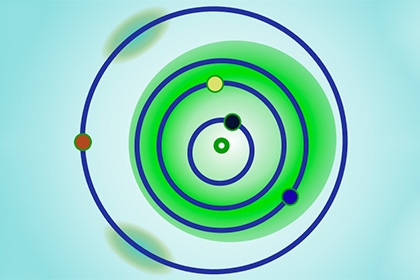Icarus asteroid makes close approach to Earth
 15:55, 16 June 2015
15:55, 16 June 2015YEREVAN, JUNE 16, ARMENPRESS. An Earth-crossing asteroid with an interesting history pays our fair planet a visit this month, offering backyard observers a chance to watch it glide silently through the sky. As Armenpress informs citing Sen, the near Earth asteroid 1566 Icarus will pass eight million kilometers (five million miles) from Earth on June 16 at 19:39 Armenian time. One of early NEOs (Near Earth Objects) discovered way back in 1949 by astronomer Walter Baade from the newly opened Palomar observatory, this will be the closest this asteroid passes by the Earth since 1968 and until 2090. About 1.4 kilometers in size, Icarus poses no threat to the Earth on this, or any foreseeable future pass. The June 16th passage sees the asteroid miss Earth at 20 times the Earth-Moon distance.
Icarus created quite a stir on its last close pass in 1968, when it came as close as 6.4 million km (four million miles). It was the subject of a famous study dubbed Project Icarus, which was launched by the Massachusetts Institute of Technology (MIT) to look at whether NASA could deflect the asteroid, using existing technology, if it were on a collision course with the Earth. The 1968 passage of Icarus was the closest pass by the Earth of a large asteroid at that time, and it actually generated a minor bit of concern, despite publicity campaigns by astronomers to calm the public. It all seems rather quaint today, as we now have the capability routinely to detect several asteroids a year passing the Earth closer than the distance of the Moon. One fringe group in 1968 even purportedly took to the mountains of northern California to escape a feared tsunami triggered by the asteroid! Project Icarus was also the inspiration for the 1979 sci-fi film Meteor, which centered on efforts to deflect a killer asteroid headed towards Earth. Icarus will be visible in backyard telescopes around the 16th, and the folks at the Virtual Telescope project will also broadcast the approach live. Watch for Icarus as a 10th magnitude “star” gliding through the constellation Canes Venatici near the Bigger Dipper asterism on the night of June 16th. At its closest on June 16th, Icarus will be really moving, appearing to cover three quarters of a degree—1.5 times the diameter of a Full Moon—every hour. The JPL ephemeris generator is a great resource to get tailor-made coordinates for the asteroid in right ascension and declination for your location.
If clouded out, or you live on the wrong hemisphere of the planet, you can watch the passage of the asteroid using the Virtual Telescope Project which has a live webcast set to follow Icarus starting at 23:30 UTC on the night of June 16th. It is also interesting to note that Icarus also lives up to its mythological namesake and passes 0.187 AU from the Sun during its perihelion passage. This is equal to 29 million kilometers, or 63 per cent of the perihelion distance of the planet Mercury. This also makes Icarus unique in that, like Mercury, the effects of general relativity and solar oblateness (how much the Sun varies from spherical) play a measurable factor in perturbing its orbit. Icarus has also long been the suspected source of the daytime radio meteor shower known as the June Arietids that emanate from the constellation of Aries the Ram. Like “rock comet” turned-asteroid 3200 Phaethon, which is the source of the December Geminid meteor shower, Icarus might be a captured comet nucleus that gets periodically baked during close perihelion passes and is shedding material along the path of its orbit. Icarus held the record for the asteroid with the closest perihelion passage to the Sun until the discovery of asteroid BD19 2000 on Jan. 26, 2000. Icarus is one of a few dozen asteroids known to cross the orbits of all four of the inner planets. Icarus also has a high rotation rate of just over two hours. About two thirds of near Earth asteroids with rapid rotation rates are known to have tiny moons, though none have yet been found orbiting Icarus. Icarus was also the first asteroid ever to be observed using radar in 1968. Fast forward to 2015, and positional measurements made of Icarus using radar will prove valuable for testing and measuring general relativity. Icarus also has a complex orbital resonance that assures that it will have close passages by the Earth once every nine, 19 and 28 years, respectively, and always in June. We have never visited Icarus thus far, but the NEAR/Shoemaker spacecraft did visit Eros, a similar twin NEO asteroid. And though Icarus passes near Earth frequently, its high relative delta-v does not make it a good candidate for future crewed exploration. “The asteroids being considered for manned exploration all have one thing in common,” Jet Propulsion Laboratory’s (JPL) Ron Baalke told Sen. “They all have Earth-like orbits. Icarus does not fall into this category. The delta-v to reach 1566 (Icarus) is rather high: 15 km/s. As a comparison, the delta-v to reach the Moon is 6.0 km/s, and for Mars it’s 6.3 km/s.” JPL’s Amy Mainzer also told Sen that Goldstone has plans to observe Icarus June 13 through the 21, and Arecibo will attempt observations from 17 to the 21. The next good opportunity to use Arecibo to observe Icarus won’t be until a more distant pass in 2024. 1566 Icarus is one to watch this month, either from your backyard or online as this history-making asteroid with a penchant for flying too close to the Sun visits our cosmic neighborhood.





















